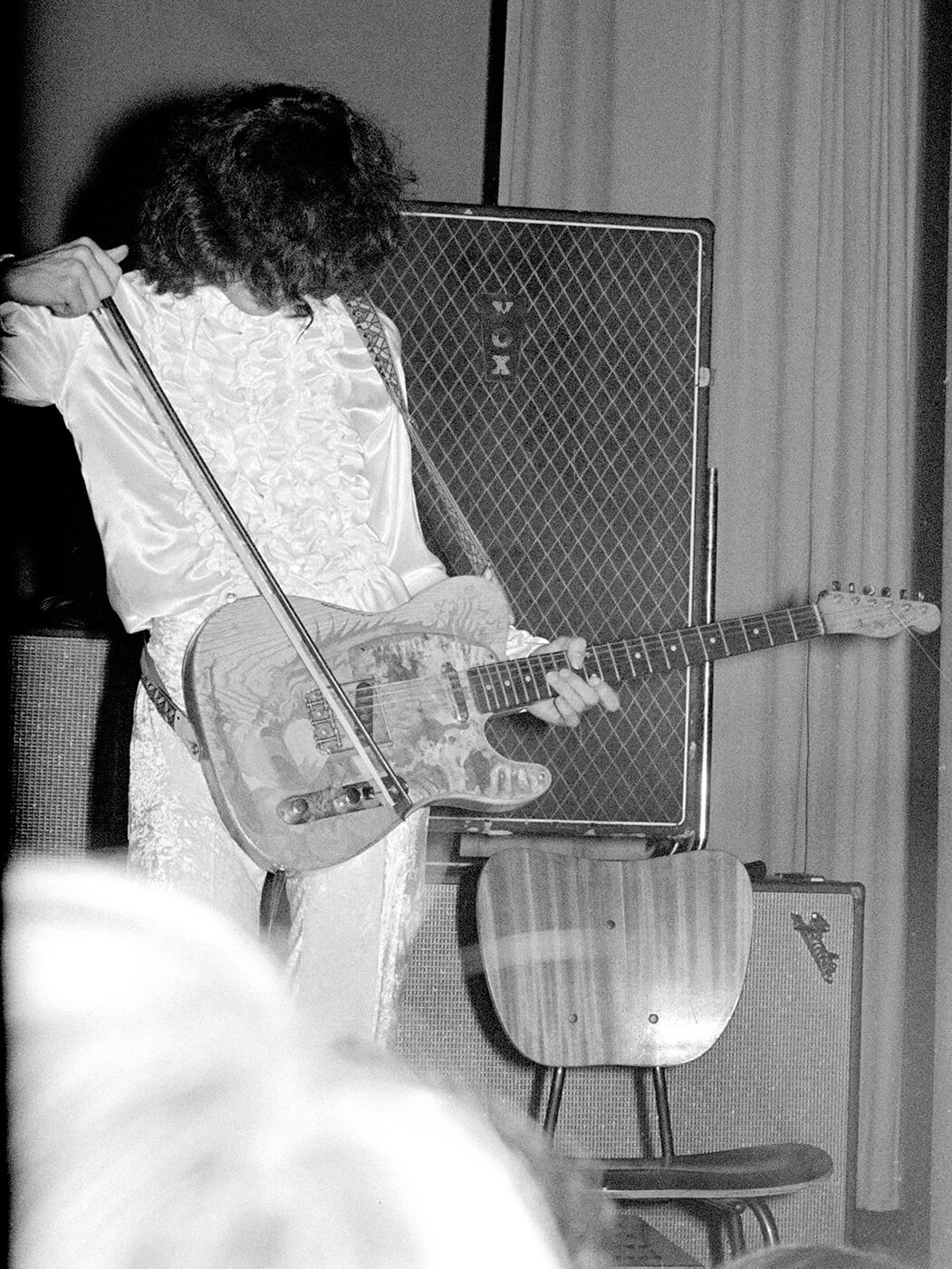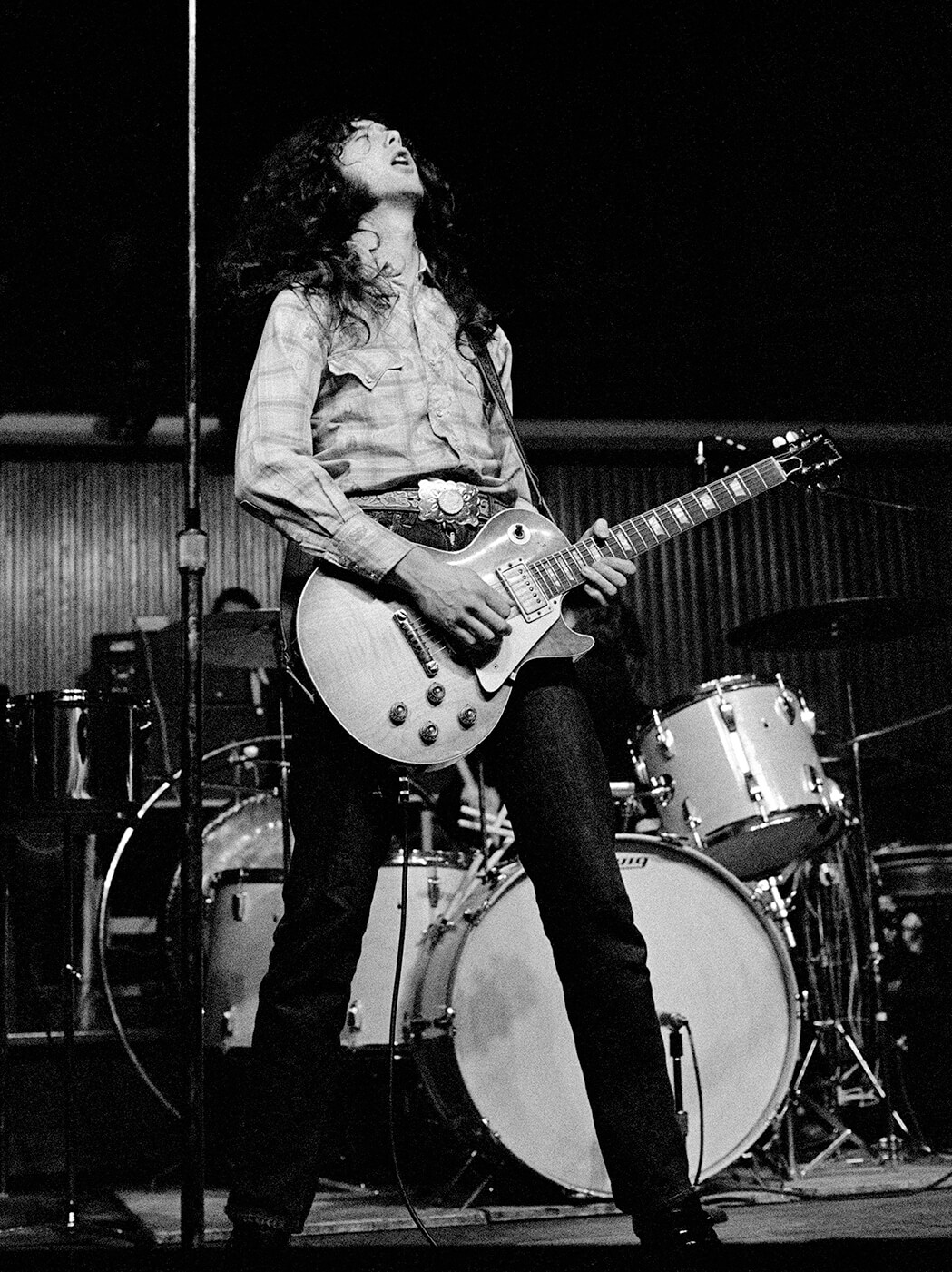Related Tags
The inside story of Jimmy Page’s Led Zeppelin guitars
As a brand-new book gives us an up-close look at Led Zeppelin’s earliest days, we take a trip through the iconic instruments that Jimmy Page used in his career as the band went from club gigs to rock ’n’ roll superstardom.
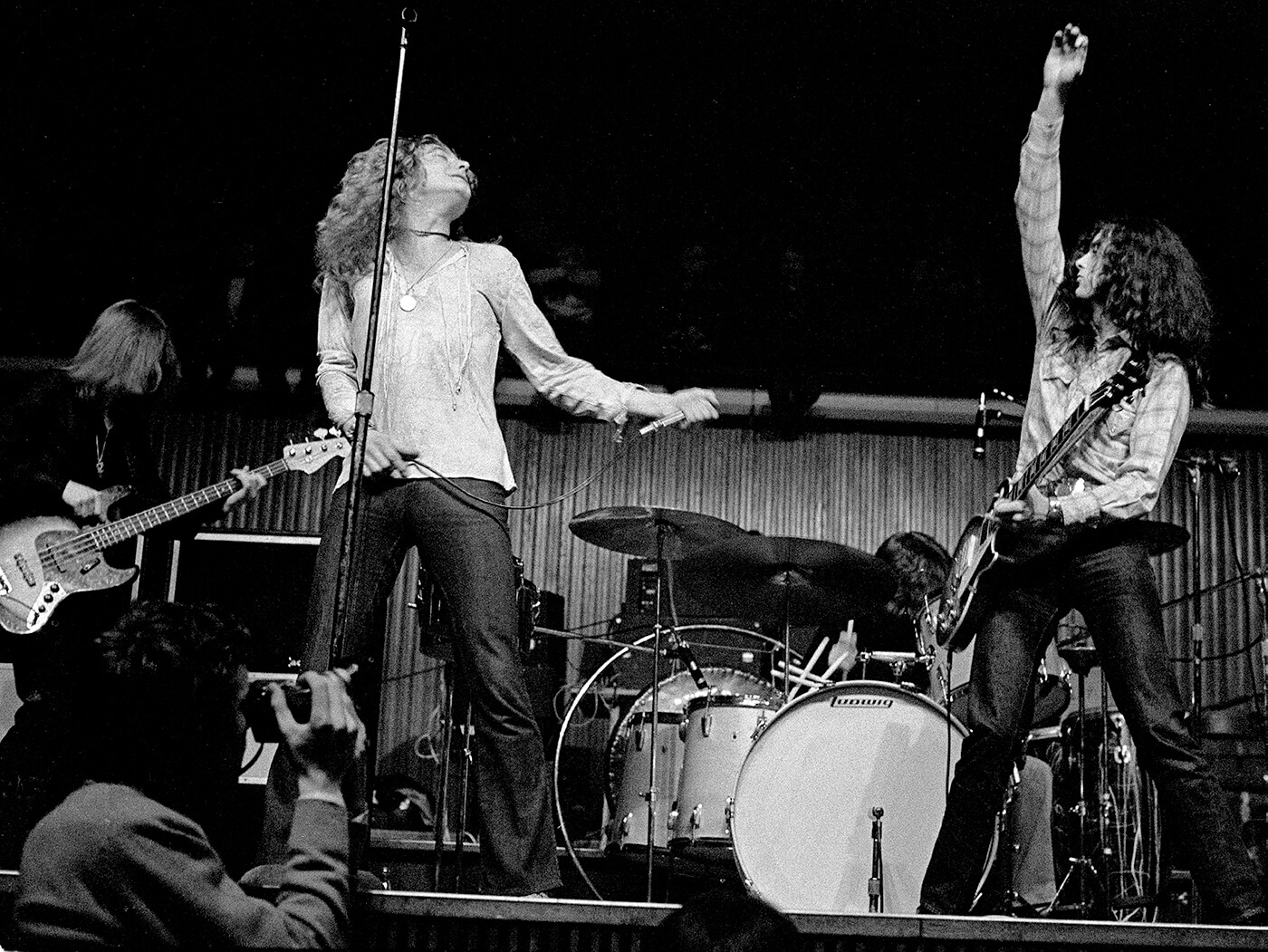
Led Zeppelin were back
in Denmark to play
K.B. Hallen in Copenhagen
on 28 February 1970. All images: Jørgen Angel
Any photographer worth their salt will tell you that being in the right place at the right time is an essential part of getting a great shot. For Jørgen Angel, the place was the Teen Club in Gladsaxe, Denmark and the date was 7 September 1968. Fans of Led Zeppelin will know the date and the venue well – it was the first time that Jimmy Page, Robert Plant, John Paul Jones and John Bonham played together live, fulfilling an existing contractual obligation to tour Scandinavia left over from Page’s Yardbirds days.
When Page and co rolled into town, Angel was an aspiring photographer who had become the Teen Club’s in-house snapper and made a point of shooting the many bands that came through the Gladsaxe.
“I’d been looking forward to hearing The Yardbirds again, but when I arrived I saw a handwritten poster stating ‘The New Yardbirds’!” he recalls. “Then I knew something was wrong. Imagine that you had bought tickets to The Beatles and then ‘The New Beatles’ turned up instead!
“Only one of the original members was left in the band – three completely unknown musicians. But when The New Yardbirds came on the stage and started playing, I was happily surprised by their energy. I was so captivated that I used a roll-and-a-half of film on them – and that was expensive for a school boy!”
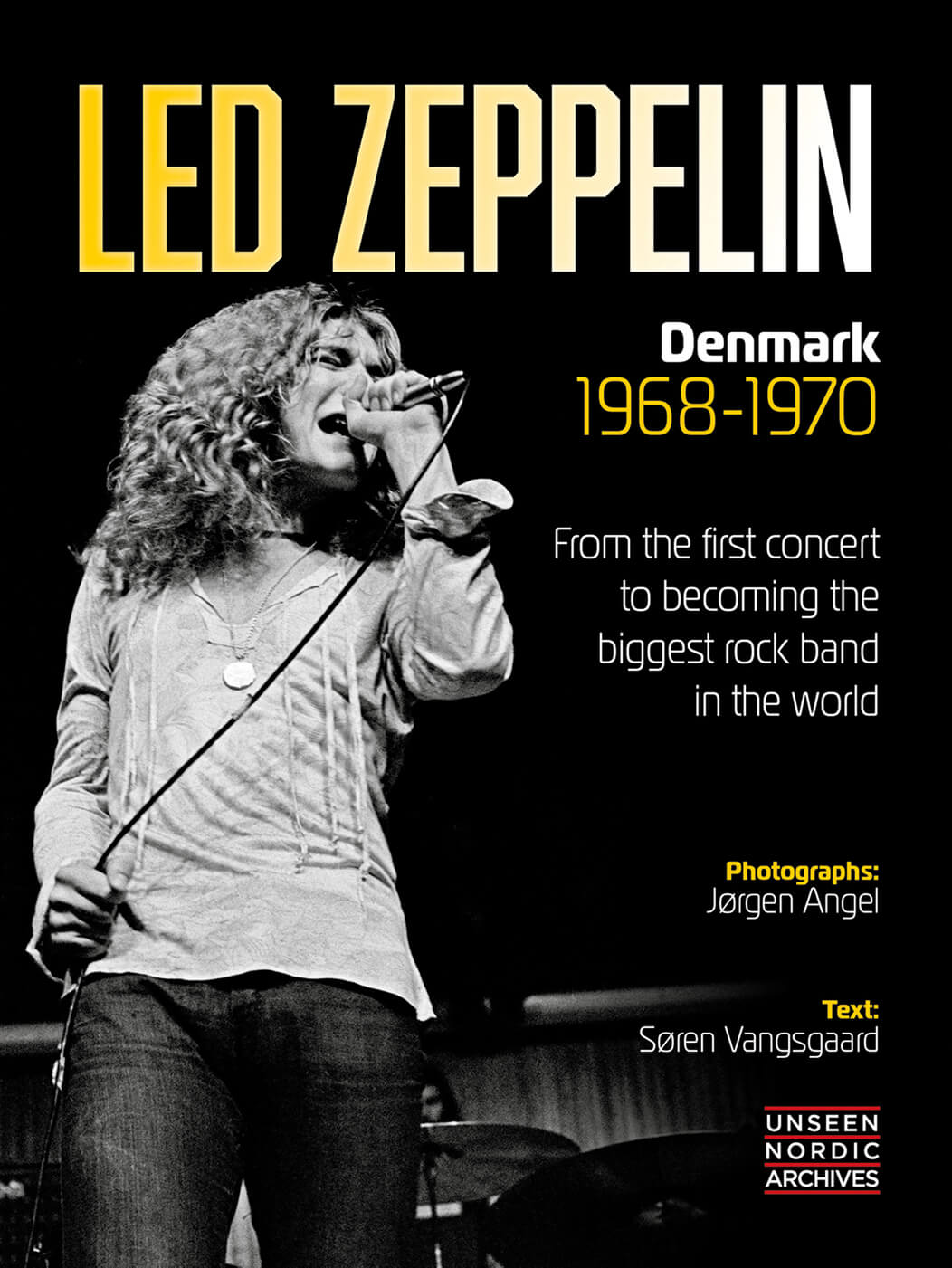
But what Angel saw that night clearly made an impression and the young photographer decided that this new band would be worth documenting further – and so that’s what he did. Through the photography collected in a brand-new book, Led Zeppelin, Denmark 1968-70, Angel charts the journey of the band from that first concert to becoming the biggest act in the world.
But Angel’s book does more than showcase the rise of one of the greatest rock bands in history, it also documents the evolving guitar choices of the band’s founder, Jimmy Page.
By the time Page formed Led Zeppelin in the late summer of 1968, he’d already been through quite a few guitars. As a schoolboy, he’d started with the inevitable Höfner, then moved onto a Futurama, which he played with Neil Christian & The Crusaders. He recalled flirtations with a Strat and a 6120 along the way and found himself a Harmony Sovereign acoustic.
For his job as a busy session guitarist on the 60s London circuit, he acquired a Les Paul Custom and a Danelectro 3021. Next, it was The Yardbirds, at first on bass playing the band’s Epiphone Rivoli, then switching to guitar. It must have seemed like he’d really arrived. Little did he know what was in store…
1959 Fender Telecaster
Think of Jimmy Page in Led Zeppelin and probably the first guitar that comes to mind is a sunburst Les Paul, or maybe that spectacular double-neck. At first, however, he played a Telecaster that he brought with him from The Yardbirds. From Zep’s first appearance in 1968 that’s immortalised in Jørgen Angel’s photos, it was clear that this was no ordinary band. And the guitar Jimmy played was no ordinary Tele, either.
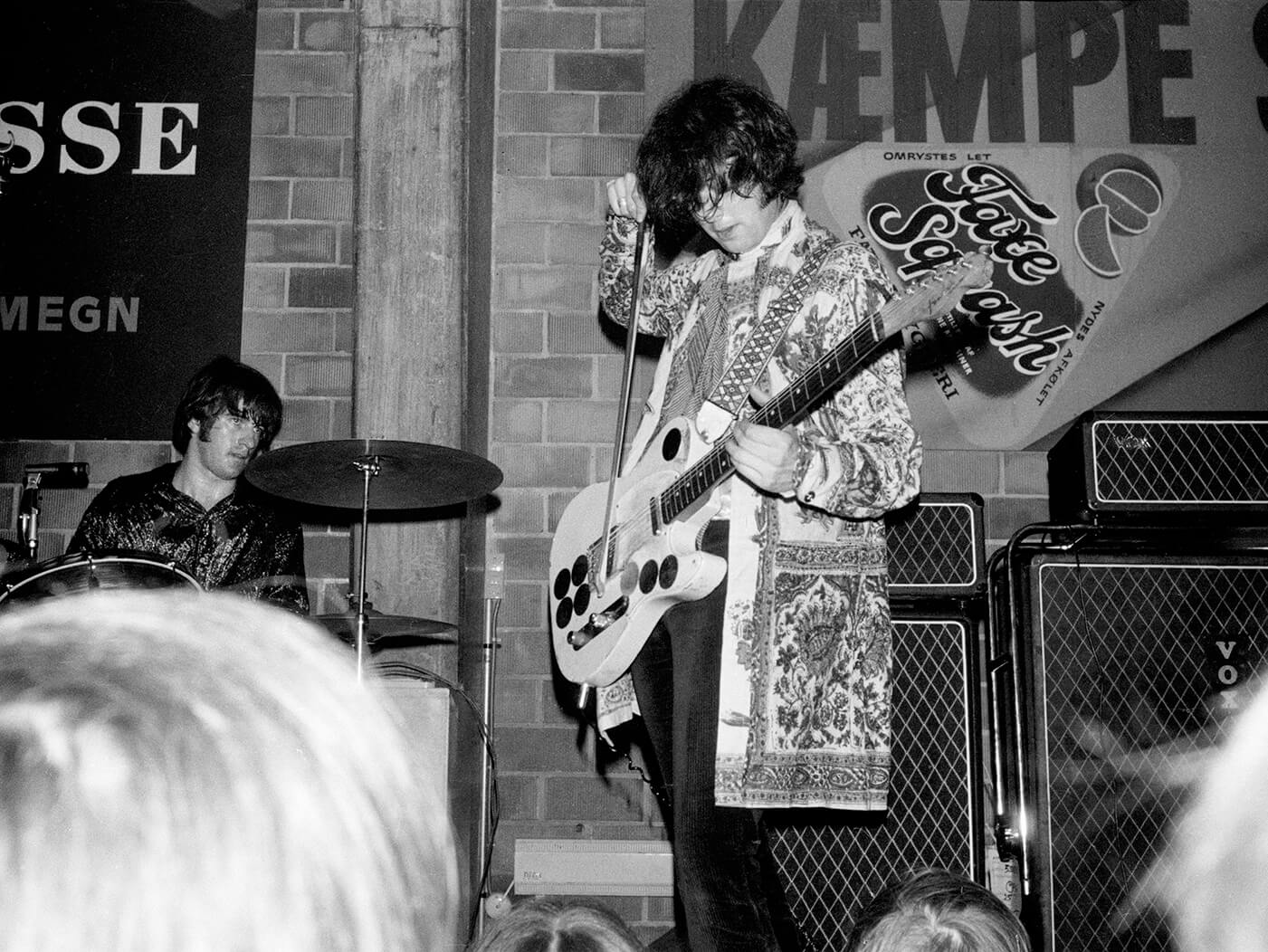
In The Yardbirds, Jimmy had worked alongside Jeff Beck since joining in the summer of 1965 and when he shifted to guitar, he mostly played a Telecaster borrowed from Jeff. When Jeff left The Yardbirds at the end of 1966, he took his favoured Burst with him and left the Tele in Jimmy’s hands. Its status as a 1959 example can be seen in the rosewood ’board and the top-loader bridge with optional string-through holes.
When Jimmy first began playing the Tele in The Yardbirds, it had its original finish, but during the early months of 1967 he decided it needed something more distinctive. Maybe he’d seen Syd Barrett’s Esquire with its body covered in plastic sheeting and silver discs? Jimmy said it was the use of mirrors in fashionable jackets and dresses of the day that inspired him to add eight mirror-finish discs to the front of his Tele’s body and he enjoyed making them flash and glitter in the stage lights.
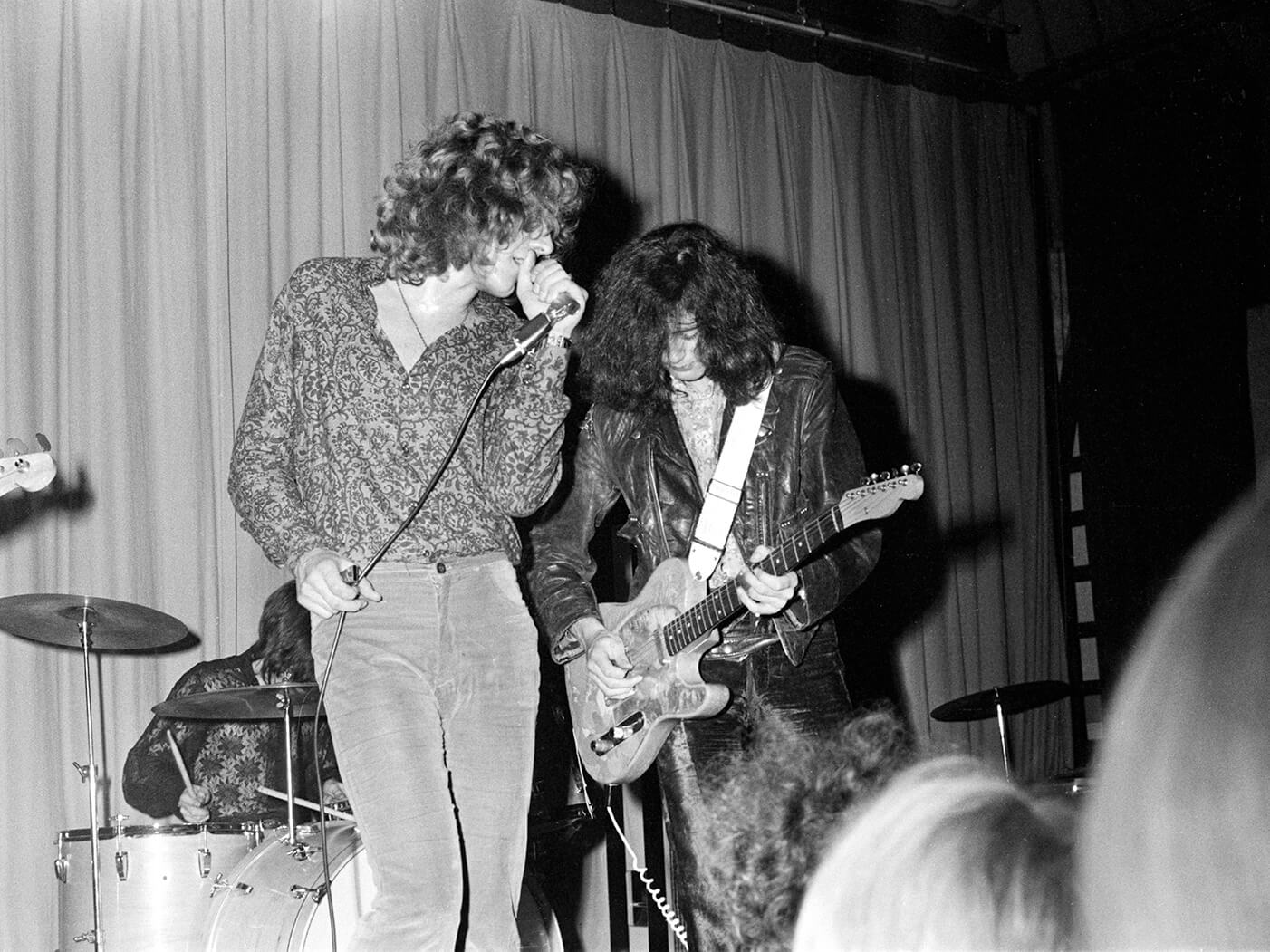
That look didn’t last long, though, and a few months later – perhaps this time he’d seen Eric Clapton’s painted ‘Fool’ SG? – Jimmy removed the discs, stripped the body down to natural figured ash and painted it with a design that’s become known as the Dragon. Jimmy said he exploited the way opposite colours vibrate, in this case mostly red versus green. He replaced the pickguard with a transparent guard that had a sheet of film underneath to enhance the colourful vibe.
It was with this look that the Telecaster accompanied Jimmy when he formed Led Zeppelin and he used it to record the band’s first album and on the gigs they played, from their debut in September 1968 through to April 1969. By that time, the road-weary Telecaster was coming to the end of its days, most evidently with a problematic pickup that was beginning to get on Jimmy’s nerves. Even the manager noticed: Peter Grant said later, without too much exaggeration, that every night on tour Jimmy had to get his soldering iron out to make the Telecaster serviceable. What he really needed was a different guitar to take him to the next phase of his career with Led Zeppelin.
There was, however, at least one further outing for the Telecaster with Zep. Around the turn of 1970 into ’71, the band were in the studio and one of the pieces they were working on became Stairway To Heaven. When it came to the solo, Jimmy pulled out the Tele once more (no doubt checking first that the pickups were delivering properly). About six minutes into the marathon song, he built a logical, satisfying statement on his Telecaster that perfectly suited the lofty surroundings. It was a fitting close to this opening chapter of the story of his Led Zep guitars.
Gibson Les Pauls
When Joe Walsh of the James Gang took a Les Paul Burst to show Jimmy at a Zep date in America in 1969, Jimmy recognised that here was a potential replacement for his ailing Telecaster. The meeting most likely took place at the Fillmore West in San Francisco at the end of April. Jimmy bought the ex-Walsh Burst and was seen playing it straight away, certainly by the time Zep played Pasadena in the first few days of May.

He knew he had a gorgeous Les Paul and very soon it came to define his sound and his future with Zeppelin. More immediately, he knew that toward the end of May, the band would start work on their second album and he wanted just such a reliable, playable guitar for this important job.
The Burst remained Jimmy’s favourite guitar through most of his time with Led Zep and eventually it would be known as ‘Number 1’ once he acquired others. Walsh had done some work to the guitar, including shaving its neck to an unusual profile. Jimmy described it as a “shallow neck” and in fact, it had been shaved almost to the truss rod in the centre section.
Roger Giffin, who later made a replica of Number 1 for Jimmy, told me the asymmetric profile was “like a section through an egg, deeper on the bass side than the treble”. But it worked for its new owner and that’s all that mattered.
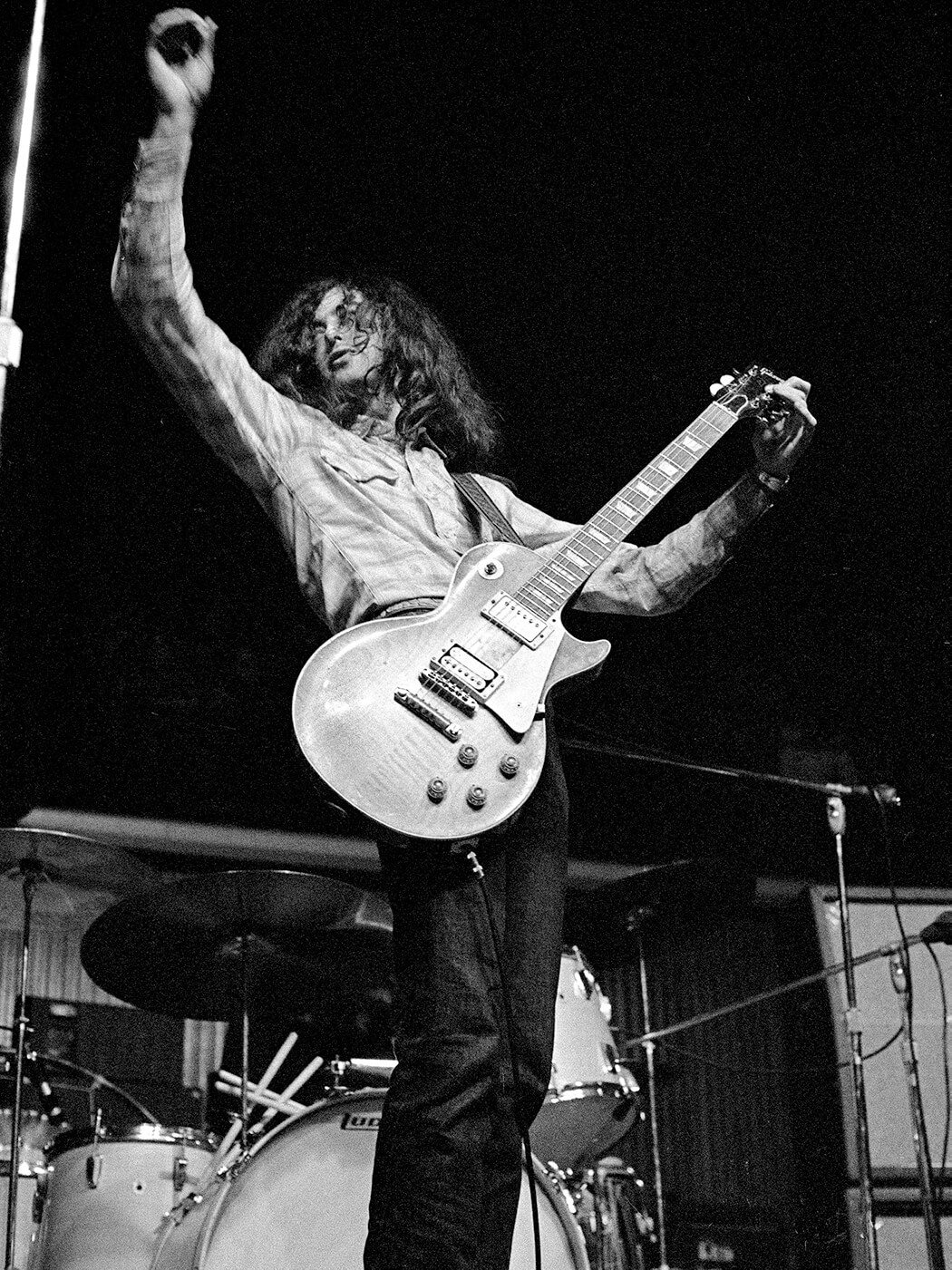
Jimmy made a sensible mod by quickly changing the ex-Walsh guitar’s tuners from the notoriously fragile originals to a robust set of gold-plated Grovers, a type that he was familiar with on his Les Paul Custom acquired back in the session days. The bridge-pickup cover came off, too, revealing double-white bobbins and the switch cap was in the wars, going through a few changes.
There’s nothing unusual in any of this: it was a busy working guitar that otherwise held up very well. A headstock repair probably done during Walsh’s ownership had removed the guitar’s serial number, so an accurate production year will never be possible, though an educated guess would place Number 1 as probably a late ’59 or early ’60 example.
Jimmy got another Burst during his time in Led Zeppelin, probably in 1973, an instrument later known as ‘Number 2’. This one was serial-numbered and clearly a 1959 model. He kept it mainly as a backup to Number 1, although he occasionally used it onstage, sometimes in alternate tuning for Kashmir.
Interviewers often asked Jimmy about his influences and he would talk passionately about rockabilly and blues. When the subject turned to Eric Clapton, he would say how Eric was among the first to develop and exploit the sound of a Burst plus a Marshall. But it was Jimmy who took that evolution further, putting his ex-Walsh Les Paul to use during Zep’s time at the very top of the rock tree in the 1970s, onstage and in the studio.

Not only did Jimmy and his Burst create an unforgettable onstage image, but in the studio he reminded a generation of guitarists and guitar fans just what a Les Paul could do in imaginative hands. For some, this would remain as the definitive combination of player and instrument.
“It’s hypothetical, but I may not have come up with the riff of Whole Lotta Love on the Telecaster,” Jimmy said when we discussed his Burst. “That fat sound you’re working with, you are inspired – well, I am – and I know other people are, by instruments, the sound of the instruments. And then they’re playing something they haven’t played before and it’s really user-friendly, and suddenly they’ve got some sort of riff, which is peculiar to that moment. I’m not saying that’s the first thing I played on it, but it was to come. I always knew the Les Paul was a really user-friendly guitar over, say, a Strat or something like that. It’s really sympatico. So many things start singing, you know? Really singing.”
Gibson EDS-1275
Jimmy famously used an electric 12-string to record the rhythm part on Stairway To Heaven, introducing it a little over two minutes into the song to strengthen his fingerpicked acoustic that opens the track. Naturally, the band intended to play this important piece live, but a problem quickly arose, not least because the recording also has the chiming 12-string leading straight into the six-string Telecaster solo. Even with Jimmy’s dexterity and skills, it looked like it would be hard to play Stairway live with just a single guitar in hand.
The solution came in the shape of a Gibson double-neck. Jimmy had seen pictures of American guitarists with similar concoctions: Grady Martin with a Bigsby double-neck, Joe Maphis with a Mosrite, though the inspiration came from a strange-looking band he’d seen somewhat closer to home. “I’d seen one in Family,” Jimmy said, “you remember Family? That guy had a double-neck.”

That guy was Charlie Whitney, the main guitarist in Family, who used a Gibson EDS-1275 six-and-12. Charlie had spotted a double-neck in a 60s Gibson catalogue and ordered one, which eventually arrived in Leicester in 1964.
Meanwhile, in 1971, Jimmy’s bandmates continued to tease him about the problem of reproducing live what they called the “guitar army” on the studio cut of Stairway…, so Jimmy, too, made a special order. A double-neck seemed the perfect compromise for live shows. “I asked to get one from Gibson, because I knew it was the only way,” Jimmy continued. “I knew I couldn’t do Stairway…, but it was essential to do it. So it became iconic, didn’t it?” If a little tough on the left shoulder. “Yeah, though I’ve got heavier guitars! But nevertheless, it was pretty weighty.”
Jimmy’s EDS-1275 made its live debut in March 1971, allowing him to play 12-string and six-string parts without swapping guitars and it certainly did become iconic. The popularity of double-necks grew as other players saw Zep’s guitarist toting the Gibson beast, so much so that Gibson reissued the EDS-1275 in 1975, again built only to special order.
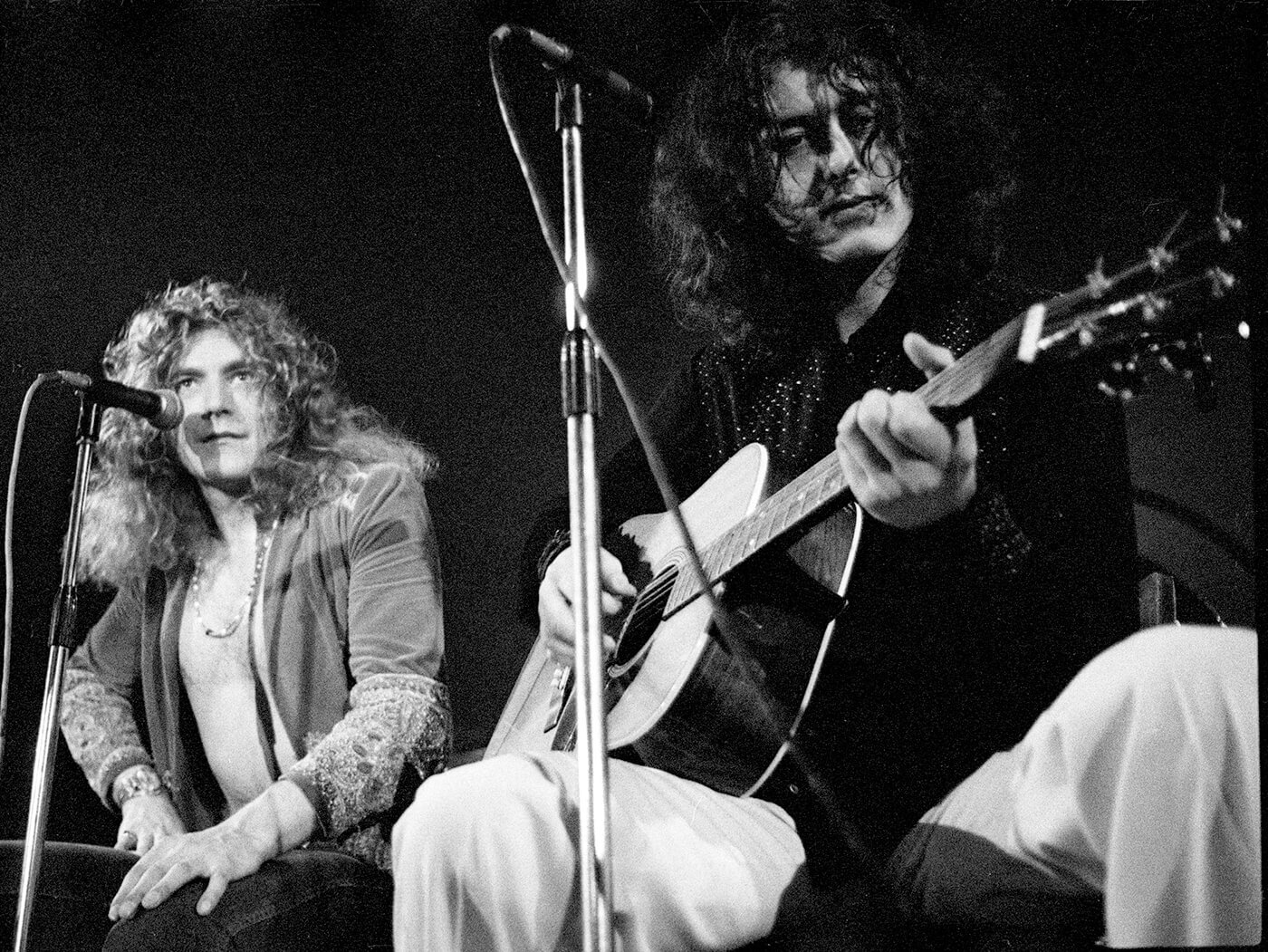
Jimmy’s other guitars
Jimmy used other guitars in Zep beyond the three main electrics we’ve covered. His flat-top acoustics weren’t often seen in performances, but of course he used them to good effect in the studio. For the first album, it’s usually his Gibson J-200 we hear, but before the third album sessions he bought a Martin D-28 and this was one acoustic occasionally seen onstage.
He first used his D-28 live in summer 1970, mic’d up for pieces like Bron-Yr-Aur, while for later tours he had it fitted with a Barcus Berry pickup. He acquired a second D-28 later in the 70s, intended for pieces that required an alternate tuning.

Jimmy had a couple of 12-string electrics – a Vox and a Fender. They were almost exclusively for studio use, although he did play his Vox Phantom XII now and again live with The Yardbirds, as can be seen in Jørgen’s Yardbirds gig images.
A further electric was Jimmy’s distinctive black-and-white Danelectro Standard 3021, another of the guitars he’d owned since his session days back in the 60s. With Zep, he used it live primarily in alternate tuning for White Summer/Black Mountain Side as well as a few other songs. Dano Standards are known also as ‘Short Horn’ models, which not only relates obviously to the shape of the body, but also to the name that Danelectro gave to a matching bass.
“I knew when it came to the time of Led Zeppelin, I knew exactly what I wanted to do,” Jimmy told me, “exactly how I was going to go about it, exactly what material. The stage was already set, the scene was set, because I’d played all those underground clubs with The Yardbirds, there was the elements of it in there. There was an audience for it, if I got a good band together. And I didn’t just get a good band, I had a phenomenon together. It was really exciting! Imagine!”
Led Zeppelin Denmark: 1968-70 with photography by Jørgen Angel and words by Søren Vangsgaard is available on 28 May 2019 via Flying V Books.


